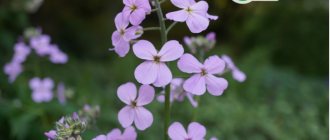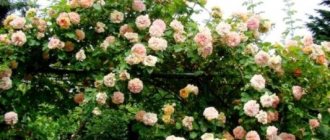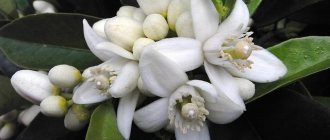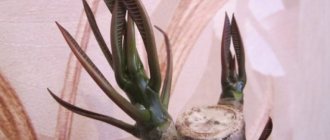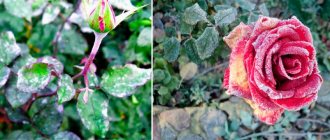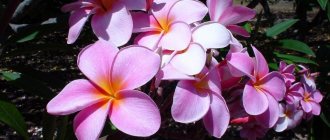Plumeria or frangipani - this plant can rightfully be considered divine. Plumeria flowers have a persistent, exquisite aroma and do not lose their beauty when picked for a month. Tropical islands with a mild and humid climate are considered the homeland of this unusual flower. For the first time, travelers saw this flower in the Caribbean islands. It bloomed on a huge tree, at least ten meters high. And its aroma was incomparable to more than one flowering plant. A feature of plumeria is the ability to change its aroma depending on growing conditions. It is quite difficult to describe the smell of this plant. Each person finds in it the aroma that he wants to hear. For many, the aroma of plumeria resembles the smell of lily of the valley, hydrangea, jasmine, citrus fruits, magnolia or the subtle aroma of spices.
This plant belongs to the Kutrov family. The homeland of plumeria is considered to be South America, Thailand, Bali, Mexico and other tropical islands. In their natural habitat, there are several species of plumeria.
And it grows in the form of a mighty tree with a fleshy crown and large green leaves. Flowers appear in the middle of the plant, and not on the side shoots. And they are dense five-leaf inflorescences that do not have stamens. Their appearance has given rise to many legends and speculations about the origin of this plant. Its peculiarity is considered to be the ability of flowers, when picked, to retain their pristine beauty. The aroma after cutting the flower is also not lost and makes it possible to feel it on the skin for a long time. Flowers are a symbol of Thailand; they are used to make wreaths and decorations for tourists. They are considered the best decoration for weddings and special ceremonies. Their appearance is very important in national culture. The color of plumeria petals, depending on the plant variety, can vary from soft white to bright scarlet, it can be pink or yellow; currently there are varieties of plumeria with two colors in the color of the flower petals.
How does plumeria grow in its homeland?
Plumeria grows in hot, tropical climates. Loves moist air and constantly moist soil. It does not tolerate drying out of the soil and at temperatures below 15 degrees, the plant dies. The maximum temperature in summer is 20-25 degrees, and in the winter rest period it is not lower than 17 degrees. The root system of this plant is quite well developed, there are above-ground roots and a developed underground part. The trunk is dense and strong, withstanding tropical winds and downpours. Very often this plant was planted in cemeteries and churchyards.
A plumeria tree that blooms for a long time should remind people of eternal peace and respect for the departed. It is also called the “tree of eternity”, since even if a young shoot of plumeria is pulled out of the ground, it will continue to bloom.
Requirements for planting container and soil
The tropical tree has powerful roots, so to grow it, immediately take a spacious and deep pot. Some inept gardeners often trim large root shoots. This is very dangerous and can lead to the death of the entire plant. As well as the wrong selection of substrate. Purchased soil or prepared soil yourself from leaf turf and peat (taken in equal proportions) is suitable. Peat, humus, sand and turf are also sometimes mixed in equal parts. The main thing is to periodically loosen the substrate to provide the roots with a stable supply of oxygen.
How to grow plumeria in your own garden
Many gardeners could not help but become interested in this amazing plant. And the desire to grow it on your own plot is very great. The seeds of this plant, as well as its cuttings, can be purchased at the store or brought from tropical countries yourself. In Europe, plumeria seeds are sold immediately in bags with soil, for ease of growing. The only “but” that stops many gardeners is doubt about the flowering of this beautiful plant. The plant cannot tolerate cold weather and freezing of the soil, the root system instantly weakens and the plant dies. But the solution to this problem is quite simple - you can grow plumeria in a flowerpot and take it from the street in the autumn and winter. Or plumeria grows well in greenhouses and winter gardens, subject to certain conditions.
Diseases and pests
Root system rotting. The reason is stagnation of water in the root system due to excessive watering. The problem can be solved by replanting the plant and removing damaged parts of the root. Root sections must be sprinkled with wood ash.
Among the pests, the main enemies of plumeria are considered to be mealybugs and spider mites; they can be eliminated using special products, which are widely available in gardening stores.
Spider mite
Mealybug
Growing plumeria from cuttings
- To grow plumeria from a cutting into a young plant, it is necessary to observe certain conditions and know the characteristics of the development and growth of this plant. If you bought a cutting in a store, be sure to inspect it for leaf diseases. If possible, inspect the root system. At home, the plant must be replanted in a fresh earthen mixture; for this you can use light soils for flowering plants or mix one part of humus, two parts of earth and rotted leaves or pine bark yourself.
- The soil for the plant should be slightly acidic. Expanded clay or broken bricks should be placed at the bottom of the container; this will help prevent rotting of the roots with constant watering. It is better to choose a plastic container for planting, since clay containers can injure the roots of a young plant, do not allow sufficient heat to pass through, and they are quite heavy. And plumeria needs to be replanted every year. The earth mixture should be well moistened, after which a young cutting is placed in it.
- If the plant has more than three leaves, this indicates that the plant is in good condition. The young plant is a thick stem with a rosette of leaves at the top. If there are side shoots, this indicates that the plant is not very young and may have undergone flowering. On the stem of a plant you can sometimes see “stretch marks”, a young formation of bark; this is not damage, but is typical for some types of plants. It is better to plant during the plant's dormant period, which occurs from October to March.
Frangipani is a magical flower that is called the “Plant of Life”. Their extract is used in perfumery, as they have an intoxicating and delicate aroma.
What a Fragipani flower looks like: photo and description
The plant captivates not only with its aroma, but also with its beautiful yellow-white flowers. They have long and soft petals with an intoxicating aroma. The ancient Indians believed that the plant symbolizes the endless life of our soul.
Previously, the Frangipani flower was worshiped by many peoples; it symbolized for them divinity, love, and sensuality. You will see a photo of a frangipani flower below; it will captivate you with its beauty and tenderness.
Check out our post Jasmine Oil: Benefits and Applications
While it was once used to decorate hair, today it is used to produce an essential oil that has many benefits. The product is used in perfumery, and you can also arrange an aromatherapy session with it.
Frangipani (frangipani) essential oil: benefits
The best perfume in the world . Thanks to its unusual and light aroma, it is used instead of expensive perfumes and eau de toilette, and it also acts as a natural aphrodisiac. Add a few drops of oil to your cream and lubricate their wrists and earlobes. Believe me, this scent will make a lasting impression on any man! According to Feng Shui, the flower symbolizes femininity and tenderness; almost every woman will like its aroma.
Will relieve depression and stress. Frangipani essential oil will bring harmony into your life, it restores your connection with nature and the world around you. If you are tired and want to recover, be sure to have an aromatherapy session at home using this oil.
It lifts your spirits. Have you been tormented by the blues lately and are you constantly in a bad mood? Thanks to the aroma, your mood will become much better, be sure to take advantage of its magical properties!
Restores and moisturizes the skin. It has regenerating properties, so it is used in skin care products and for massage. You can add 5-6 drops of oil to 1 tsp. cream and lubricate the skin with it. You can also make a mask - mix a few drops of frangipani oil and 1 tsp. any vegetable oil, apply the mixture to your face and neck for 30-40 minutes, then rinse. After just a few uses, you will notice that the skin has become more toned and small wrinkles have disappeared.
Treats insomnia. The oil has a sedative effect, thanks to it the quality of your sleep will improve, you will stop suffering from insomnia. The aroma will also calm your mind and relieve tension and stress.
Relieves inflammation. The product has antioxidant and anti-inflammatory properties, the oil eliminates harmful toxins and prevents the effects of free radicals on the body.
Will relieve you from headaches . Are you worried about a headache or migraine? A natural remedy for migraines is frangipani oil, which also relieves back pain. The oil relaxes muscles and blood vessels, improves blood circulation.
Aphrodisiac. Frangipani essential oil is a natural aphrodisiac that stimulates sexual desire and increases attraction. If you are going on a date, be sure to lubricate your skin or clothes with it.
As you can see, this product is truly unique in its properties, and its aroma will not leave you indifferent, because it is not for nothing that it is so widely used in modern perfumery.
Fragipani in perfumery
Today we want to introduce you to types of perfumes that contain an extract of this plant. It is present in Frangipane delle Maldive, Hawaiian Plumeria, Pink Frangipani, The Garden Party Frangipane. In any case, be sure to check with your sales consultant which eau de toilette contains frangipani extract.
Women's magazine Delafe.ru
Plumeria care
After planting, the plant needs regular watering and frequent spraying. Plumeria loves warm, settled water for irrigation. Does not tolerate drying out of the earthen coma. The plant is sprayed daily with clean warm water. In the active growth phase of the plant, spray in the morning and evening. In the slow growth phase, once a day is enough - in the morning. The root system of plumeria develops quite quickly, and the growth of the plant itself depends on its development. Plumeria is a tropical plant and with proper care it should be replanted every year. It is better to do this in April. After five years, the plant can be replanted every three years. When replanting a plant, you need to trim the lateral and main roots by five centimeters. This allows the root system to develop and the plant to bloom better. In mature plants that are not replanted, the top layer of soil must be changed twice a year. Throwing out the old soil and replacing it with new. You also need to mulch the top layer of soil of the plant, protecting it from drying out and washing away. You can mulch with coconut fiber or perlite. The plant needs to comply with the light regime. There should be at least six hours of daylight. In this case, plumeria can be in the open sun. If there is not enough light, the leaves begin to turn yellow and appear more lethargic. During the entire period of life, the plant should receive the maximum amount of light. If you take the plant into the house for the winter, then make sure that it stands in the southern room near the window or on the windowsill. The plant does not like drafts and freezing of the soil. If the floor is cold, you can place planks or soft cloth under the container.
During the growth period, the plant must be fed. Fertilizers can be purchased from the store for flowering plants. In the first months of spring, fertilizing with nitrogen fertilizers is necessary. During the summer months, in extreme heat, fertilizing is not recommended.
Plumeria varieties for growing in our climate
In our climate, three varieties of plumeria give the best growing results.
- Red plumeria is the most common plant variety. It has a rather fragile trunk, and requires pruning of flowers after they fade. At the same time, it grows well, grows beautiful, large leaves and quite large bright scarlet flowers.
- Plumeria obtuse is the smallest plant and has the appearance of a subshrub. The leaves are dark green, veiny, sometimes curled. The color of the flowers is predominantly yellow or white with a yellowish tint. An easy plant to grow, most resistant to temperature changes.
- Plumeria alba is a classic type of plant. It looks like a tree with large leaves. It blooms with large, white flowers, which may have a yellow eye in the middle of the flower.
Secrets of plumeria flowering
The main requirement of gardeners is the flowering of plumeria. But this process is long and not always successful. If the plant is grown from cuttings, then flowering occurs after 9-12 months of cultivation. If the plant is grown from seeds, then you will have to wait much longer for flowering, about three years. For successful flowering of plumeria, it is necessary to ensure its comfortable air temperature, proper watering and spraying, fertilizing with fertilizers and crown formation. As a rule, all lateral shoots and shoots that grow on the trunk must be removed. It is worth noting that plumeria has poisonous juice. And all work on crown formation should be carried out with gloves. Plumeria blooms on young shoots of the current year; if they are removed, flowering does not occur. If everything is done correctly, the plant will delight you with abundant color and aroma for a month or more. Flowers with a unique aroma and color will give the plant a solemn and festive look.
Frangipani from seeds
The easiest way to get this plant is to buy and plant a seed.
Which is what I did. Seeds today are not difficult to find; they are sold on specialized websites and in social networking groups. The main thing is to find a website that is convenient for you and place an order. The seeds are frost-resistant, so they can be ordered all year round. The cheapest Frangipani seeds I've come across cost 25 rubles. Video on the topic:
Germination is a lengthy process, it took me about a week, and you have to be very careful not to destroy the seedlings. First you need to prepare a very light soil that will dry quickly and not sour. I used universal soil with a large amount, about 50%, of disintegrants (perlite, silica, zeolite, vermiculite are suitable). Next, I placed the soil in the greenhouse, moistened it thoroughly and stuck the seeds into it with the wings facing up. The greenhouse must be kept warm (in winter you can use a radiator or a shoe dryer), ventilating it a couple of times a day so that the seeds do not get trapped.
We grow plumeria in a flowerpot or tub
Growing plumeria in flowerpots allows the plant to be in the fresh air in the countryside or in the garden during warm periods. The pot with the plant should be placed in a well-lit place, making sure to place a board or other flat surface under it. This will provide the plant with protection from ants and other insects. Spraying and watering are done daily, even several times a day. With proper care, you can grow a tree or shrub up to two meters high. It is necessary to inspect the leaves of the plant daily, especially from the inside. And to avoid the plant becoming infected with spider mites, it is better to treat it with an insecticide. During the budding and flowering phase, you cannot spray the buds, only the leaves. At the end of flowering, the plant needs pruning.
Interesting fact about plumeria . This plant has another name - frangipani. It received this name thanks to the famous Italian perfumer and nobleman, who was the first to reveal the amazing properties of the essential oil of this plant. And based on it he created the first plumeria scent. The aroma later gained worldwide fame. And now it is considered one of the most powerful aphrodisiacs. This smell brings satisfaction and tranquility to a person, introducing a note of peace and pleasure.
Join our Facebook group
Propagation by cuttings
It is convenient to propagate plumeria using young shoots - cuttings. They quickly take root and begin to bloom within a year after rooting. You can cut “babies” from the mother tree at any season, but it is advisable to do this in winter or autumn. To do this, the semi-lignified tops of long shoots are cut at an angle of 45 degrees. Remove all leaves from them and sprinkle the cut areas with crushed activated carbon. The shoots are wrapped in a clean, damp cloth and stored in a warm place for several weeks.
Then they are soaked in a rooting solution and placed in separate small flowerpots with universal loose soil. Place drainage at the bottom, such as large pebbles. Then lay out the soil and a layer of moistened river sand. It is necessary so that the cuttings do not rot. The top of the shoot is again sprinkled with prepared soil and lightly compacted. At the end, light watering is carried out. Flowerpots with young shoots are placed in a warm room. After 2-3 months, with successful rooting, young buds appear on the cuttings.
